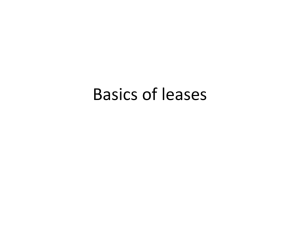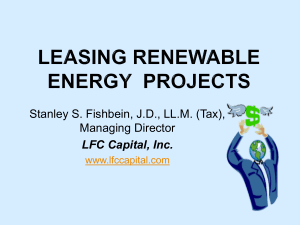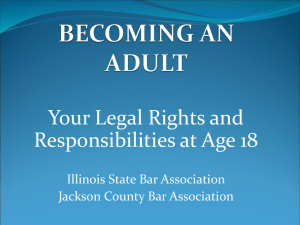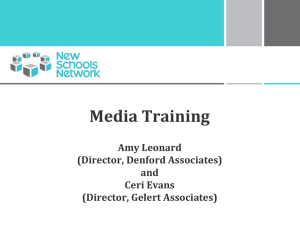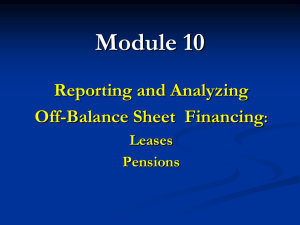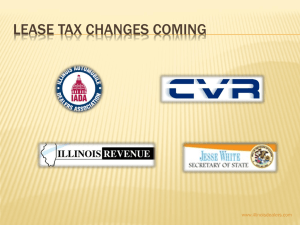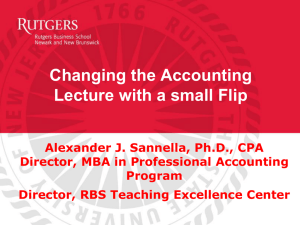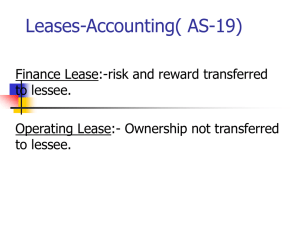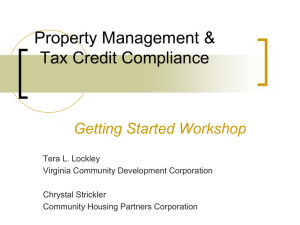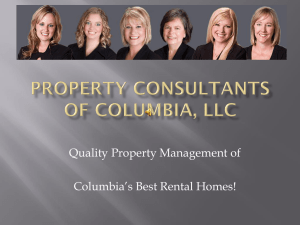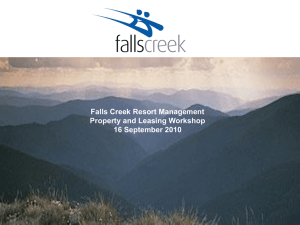Lesson 10 - Location Selection
advertisement
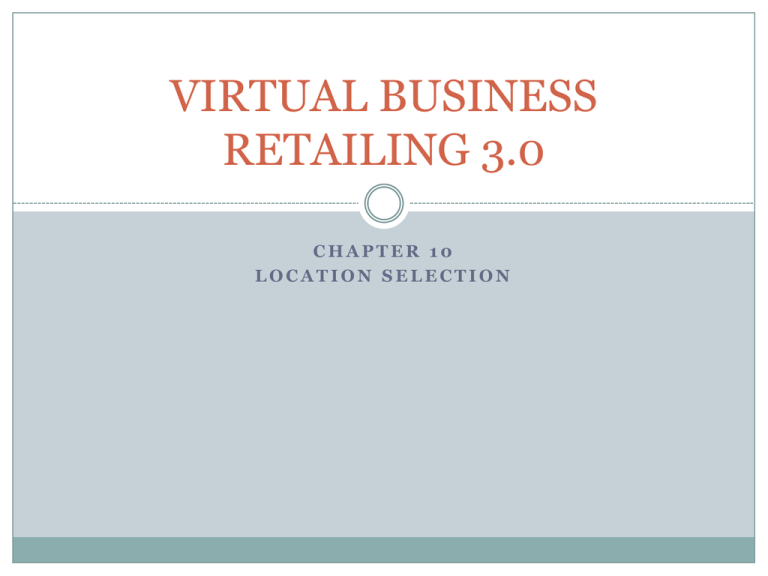
VIRTUAL BUSINESS RETAILING 3.0 CHAPTER 10 LOCATION SELECTION In this unit we will study the topic of choosing a location for a retail store We will look at different types of locations for a store and the elements to consider when selecting a location We will then discuss the merits of buying, leasing, or building a store We will also examine the types of leases a retailer might consider Lastly, we will turn to the advantages of locating near a competing or complementary business, dealing with a changing business environment, and math relating to site selection After completing this lesson you will be able to: List the elements of a good location Explain the pros & cons of locating near a competitor Discuss the financial impact of buying, building, or leasing Calculate rent payments based on different lease terms Compare locations & choose the best site for a business Location is Important Location is one of the most important decisions a retailer makes It can make a big difference in the success of a store There are many factors a retailer must consider before selecting a location Store’s target market A retailer must confirm that the store’s target market (the customers the store seeks to attract) shops in the trading area Potential location’s trading area When studying potential locations, the retailer must consider traffic & convenience as well as the attraction to the target market Types of Locations There are retail store locations in a great many places Most stores are located at Shopping centers Business districts Freestanding locations Each of these locations has advantages & disadvantages for different kinds of retail stores Shopping Centers A group of retail businesses that are located together Usually owned by a company that leases retail space to retailers 2 kinds: Malls Strip malls Malls A containment of stores serving a large area that is usually an enclosed building with an adjacent parking lot Advantages: High traffic flow to a variety of stores with a wide range of merchandise Feature department stores (anchors) as well as smaller specialty stores & restaurants Climate controlled Strip Malls Typically a neighborhood space composed of a group of separate stores that are connected by sidewalks & that have parking lots in front of the stores Advantages: Usually located close to residential areas, so they are convenient for customers Generally contain businesses that customers shop at often like grocery stores, drugstores, dry cleaners, card shops, or shoe repair shops Leasing a retail space at a strip mall usually costs less than leasing one at a mall Business Districts An unenclosed shopping area that has evolved w/o a lot of planning & that features a variety of stores Parking is usually not provided Example: The main street of downtown City governments often renovate downtown buildings in a retail space in order to attract businesses & customers to the area The cost of renting a retail space in a business district can vary a great deal depending on the popularity of the area & the other stores there Freestanding Locations A store that is unattached to other stores These locations generally have large buildings & abundant parking Advantage: For that reason they are usually chosen by large retailers No direct competition Must be able to draw customers w/o the help of other stores Examples: Home Depot, Target, Lowes Elements of a Good Location Retailers evaluate potential store locations by studying several key criteria A comparison of these factors helps clarify the best location for a particular business Criteria to consider are as follows: Trade Area Competitive Environment Traffic Convenience Additional Factors Trade Area A business’ geographic surroundings, which provide most of the customers This is the most important criterion You should locate your store in an area that serves your target market (to be discussed more in the Targeted Marketing unit) Competitive Environment Describes the proximity of competitive businesses Nearby competition is often good for a business Customers feel more comfortable about buying when they can comparison shop A location that is near a mall or large shopping area can attract customers who are shopping nearby Traffic The term used to define the number of people who go by a store location during a given time The more traffic there is, the greater the number of potential customers entering a store This is a key advantage of shopping centers Convenience A convenient location is one that is easy for customers to get in & out of The availability of plentiful & nearby parking is a factor of convenience Another factor is visibility Customers need to be able to see the store easily w/o having to search for it Additional Factors Other factors a retailer might consider are: The availability of workers Local zoning laws for the type of business, & The possibilities for expansion of the location Competing or Complementing Businesses A competitive business is one that sells the same or comparable merchandise Nearby competition is beneficial, since customers like to shop around & compare merchandise before buying Competitors can help attract customers If there is too much competition near a location, there may not be enough customers to keep all the stores in business A retailer should carefully evaluate the competition in the area before selecting a store location A complementary business is one that sells merchandise that is related to, but not the same as, an area business’s goods Example: A furniture store & a home decorating store are complementary businesses Locating near a complementary business can help attract customers for the mutual benefit of both stores Buy, Build, or Lease? Another decision a retailer must make when considering store location is whether to buy retail space, build a new store, or lease retail space In most cases, leasing may be the best & only option Buying space or building a new store requires capital & suitable locations may be difficult to find This is particularly true if the retailer is considering locating in a strip mall or a mall Most strip malls & malls are owned by companies that will only make space available through a lease agreement Lease A lease is a contract between a landlord & a tenant for use of a property for a specified amount of time in exchange for a specified amount of rent Leases have terms that detail exactly what is expected of each party The terms normally state the amount of rent, the length of the lease, services that the landlord will provide, & provisions for renewing the lease A retailer should carefully read the lease agreement before signing It is also a good idea to have a lawyer review the lease agreement Types of Leases There are 3 main types of leases that are used for most retail situations Fixed-rate lease Percentage lease Triple-net lease Fixed-Rate Lease One that charges the tenant a specific amount of rent each month This is an advantage for the retailer since the amount of rent does not vary, which makes financial planning much easier This type of lease is not widely used Percentage Lease Bases the amount of rent of a percentage of the sales generated in the space Some percentage leases have a maximum allowable rent while others use a sliding scale One that is used often Rent on a sliding scale normally goes down as sales go up For example: a retailer might pay 4% on sales up to $100,000 and 3% on sales over $100,000 Often charge an additional maintenance fee on top of the rent Triple Net (NNN) Lease One that charges the tenant rent plus the three operating costs of the rented property Those costs are for: Insurance Maintenance & utilities Property taxes The tenant pays rent as either a fixed amount or as a percentage of sales This type of lease provides the landlord with a net rent because the tenant pays for the property’s expenses This is a popular type of lease Changing Business Environments When selecting a location for your business, it is important to study the business environment The business environment forecasts whether the location under consideration is likely to experience economic growth or suffer an economic downturn To study the environment, a retailer should examine the current demographics & employment rates of the area, as well as projections for the future A good resource for this information is your local chamber of commerce This information will reveal whether the business’s target market & employment rate will remain constant or whether it will change during the time of the projections A change in target market & employment trends can mean that you will need to adjust merchandise offerings to suit changing customer needs or risk suffering declining sales Key Math Concepts Compute the amount of a percentage lease Change the percent to a decimal & then multiply this number by your sales Compute the annual amount of a fixed-rate lease Multiply the amount of monthly rent by 12 Compute the amount for the length of the lease Multiply the annual rent by the number of years in the lease Summary In this unit we have learned about the importance of store location & the types of store locations We also studied the elements of a good location We then looked at competing & complementary businesses, review the 3 types of business leases, & discussed potential changes in the business environment Lastly, we reviewed some of the mathematics associated with choosing a store location
